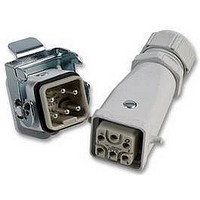H-Q-5-KIT CONTACT CONNECTORS, H-Q-5-KIT Datasheet - Page 15

H-Q-5-KIT
Manufacturer Part Number
H-Q-5-KIT
Description
CONNECTOR KIT, TOP ENTRY, HQ5
Manufacturer
CONTACT CONNECTORS
Series
EPIC HBSr
Datasheet
1.15.1238.pdf
(363 pages)
Specifications of H-Q-5-KIT
Connector Type
Rectangular
Gender
Plug, Socket
No. Of Contacts
5
No. Of Rows
2
Contact Gender
Male, Female
Connector Mounting
Cable Mount
Connector Shell Size
HQ 5
Contact
RoHS Compliant
Contact Termination
Crimp
Rohs Compliant
Yes
- Current page: 15 of 363
- Download datasheet (8Mb)
Technical
Technisches Vorwort / Technical Considerations / Préambule technique
Pollution:
Numerical value which states the anticipated pollution in the
micro-environment.
Pollution level 1:
No pollution or only dry, non-conductive pollution occurs.
This pollution has no influence.
e.g.: Open, unprotected insulations in air-conditioned or cle-
an dry rooms.
Pollution level 2:
Only non-conductive pollution occurs. Occasionally, howe-
ver, it may be anticipated that transient conductivity arises
due to condensation.
e.g.: Open unprotected insulations in residential, commercial
or business premises (fine mechanical engineering works-
hops, laboratories, test areas, rooms used for medical pur-
poses).
Pollution level 3:
Conductive pollution arises, or dry, non-conductive pollution
which becomes conductive because condensation has to be
anticipated.
e.g.: Open unprotected insulations in rooms of industrial,
commercial and agricultural companies, unheated storage
rooms, boilerhouses and workshops
Pollution level 4:
Contaimination leads to continuous conductivity caused by
condensation or other environmental contaminants.
e.g.: External exposed installations subject to all envi-
ronmental changes.
Pollution level 3 is typical for an industrial environment,
whilst pollution level 2 is typical for households.
Insulation materials:
Insulation materials are categorised into 4 groups according
to the CTI values.(Comparative Tracking Index)
Insulation material group I
Insulation material group II
Insulation material group IIIa 175 ≤ CTI < 400
Insulation material group IIIb 100 ≤ CTI < 175
Comparative Tracking Index
The test for determination of the comparative index of
tracking (CTI or comparative tracking index ) as per IEC 112
provides a comparison of the characteristics of various insu-
lating materials under test conditions. By dripping an
aqueous solution onto a horizontal surface the electrolytic
conduction can be measured. This produces a qualitative
result. When the insulating material is introduced to the
tracking a quantitative comparison can be measured, i.e. the
comparative tracking index.
C O N S I D E R A T I O N S
600 ≤ CTI
400 ≤ CTI < 600
Switch contact:
If the construction of the circuit requires that for safety reaso-
ns, e.g. for neutral conductors, one or several contacts of a
connector have to make contact first upon mating, or have to
be separated last upon unmating, then connectors with
switch (extended) contacts are used.
EMC (elecromagnetic compatibility):
The capacity of an electrical installation to function satisfac-
torily in its electromagnetic environment without an unaccep-
table influence to the environment which also includes other
installations (DIN/VDE 0870, Section 1)
Coding:
Coding is a system by which it is possible to prevent interfa-
cing confusion between adjacent connectors which are of
the same configuration. This is useful if two or more connec-
tors of the same type are mounted on the same unit.
Polarisation:
Polarisation is a method used on connectors which prevents
incorrect mating of male and female inserts eg: pin1 to pin1.
27
Related parts for H-Q-5-KIT
Image
Part Number
Description
Manufacturer
Datasheet
Request
R

Part Number:
Description:
CONTACT, SOCKET, IDC / IDT
Manufacturer:
TE Connectivity
Datasheet:

Part Number:
Description:
CONTACT, PIN, 26-22AWG, CRIMP
Manufacturer:
TE Connectivity
Datasheet:

Part Number:
Description:
CONTACT, SOCKET, IDC / IDT
Manufacturer:
TE Connectivity
Datasheet:

Part Number:
Description:
CONTACT, RECEPTACLE, AWG20-15.5
Manufacturer:
TE Connectivity
Datasheet:

Part Number:
Description:
CONTACT, PIN, AWG18.5-15.5
Manufacturer:
TE Connectivity
Datasheet:










